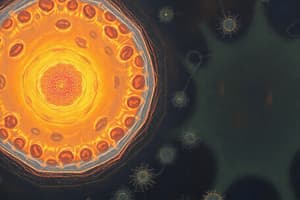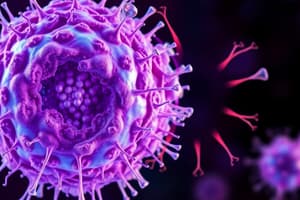Podcast
Questions and Answers
What is one of the primary functions of carbohydrates in cells?
What is one of the primary functions of carbohydrates in cells?
- Store genetic information
- Provide energy (correct)
- Insulate cells
- Form cellular membranes
Which cellular transport mechanism requires energy?
Which cellular transport mechanism requires energy?
- Active transport (correct)
- Diffusion
- Facilitated diffusion
- Osmosis
Which level of ecological organization is larger than a community?
Which level of ecological organization is larger than a community?
- Ecosystem
- Population
- Species
- Biosphere (correct)
What key mechanism of evolution favors traits enhancing survival and reproduction?
What key mechanism of evolution favors traits enhancing survival and reproduction?
What do nucleic acids primarily store and transmit?
What do nucleic acids primarily store and transmit?
What is the primary function of the plasma membrane?
What is the primary function of the plasma membrane?
Which cellular component is responsible for protein synthesis?
Which cellular component is responsible for protein synthesis?
What type of cell division results in genetically unique daughter cells?
What type of cell division results in genetically unique daughter cells?
What process involves the conversion of light energy into chemical energy?
What process involves the conversion of light energy into chemical energy?
Which organelle is primarily involved in the modification and packaging of proteins?
Which organelle is primarily involved in the modification and packaging of proteins?
What does DNA replication ensure during cell division?
What does DNA replication ensure during cell division?
During transcription, what is synthesized using DNA as a template?
During transcription, what is synthesized using DNA as a template?
What is the role of mitochondria in the cell?
What is the role of mitochondria in the cell?
Flashcards
Passive Transport
Passive Transport
The movement of molecules across a cell membrane from an area of higher concentration to an area of lower concentration, without requiring energy.
Active Transport
Active Transport
The process by which cells use energy to move molecules across their membranes against their concentration gradient.
Macromolecules
Macromolecules
The basic building blocks of life, such as carbohydrates, lipids, proteins, and nucleic acids.
Ecology
Ecology
Signup and view all the flashcards
Evolution
Evolution
Signup and view all the flashcards
What is a cell?
What is a cell?
Signup and view all the flashcards
What are prokaryotic cells?
What are prokaryotic cells?
Signup and view all the flashcards
What are eukaryotic cells?
What are eukaryotic cells?
Signup and view all the flashcards
What is cellular respiration?
What is cellular respiration?
Signup and view all the flashcards
What is photosynthesis?
What is photosynthesis?
Signup and view all the flashcards
What is mitosis?
What is mitosis?
Signup and view all the flashcards
What is meiosis?
What is meiosis?
Signup and view all the flashcards
What is DNA replication?
What is DNA replication?
Signup and view all the flashcards
Study Notes
Cell Structure and Function
- Cells are the basic units of life, exhibiting diverse structures and functions adapted to their roles.
- Prokaryotic cells (bacteria and archaea) lack a nucleus and membrane-bound organelles.
- Eukaryotic cells (plants, animals, fungi, and protists) possess a nucleus and membrane-bound organelles, compartmentalizing cellular functions.
- Common cellular components include the plasma membrane, cytoplasm, nucleus, ribosomes, endoplasmic reticulum, Golgi apparatus, mitochondria, and vacuoles.
- The plasma membrane controls substance passage in and out of the cell.
- The nucleus houses the cell's genetic material (DNA) and directs cellular activities.
- Ribosomes are the protein synthesis sites.
- The endoplasmic reticulum (ER) is involved in protein and lipid production.
- The Golgi apparatus modifies, sorts, and packages proteins for secretion.
- Mitochondria are the sites of cellular respiration, generating energy (ATP).
- Vacuoles store substances and provide structural support.
Cellular Processes
- Cellular respiration breaks down glucose to produce ATP, the cell's energy currency.
- Photosynthesis transforms light energy into chemical energy (glucose) in plant cells.
- Mitosis produces two identical daughter cells, crucial for growth, repair, and asexual reproduction.
- Meiosis creates four genetically diverse daughter cells, vital for sexual reproduction. Each has half the parent cell's chromosomes.
- DNA replication copies a double-stranded DNA molecule to ensure accurate genetic material transmission during cell division.
- Gene expression uses DNA's information to synthesize proteins, a tightly regulated process determining cell traits.
- Transcription, the RNA synthesis using DNA as a template, occurs in the nucleus.
- Translation, protein synthesis based on mRNA codons, happens at ribosomes.
- Cellular transport mechanisms regulate selective material movement across the plasma membrane involving passive (diffusion, osmosis) and active (energy-requiring) processes.
Biological Molecules
- Macromolecules (carbohydrates, lipids, proteins, and nucleic acids) are essential cellular components.
- Carbohydrates provide energy, form structures, and signal.
- Lipids store energy, form membranes (phospholipids), and insulate.
- Proteins perform diverse functions: catalysis (enzymes), transport, support, and signaling.
- Nucleic acids (DNA and RNA) store and transmit genetic information, dictating cell function. DNA carries the genetic code, RNA acts as an intermediate between DNA and proteins.
Ecology
- Ecology studies organisms and their interactions with the environment.
- Levels of organization include populations, communities, ecosystems, and the biosphere.
- Ecosystem interactions include predation, competition, and symbiosis (mutualism, parasitism, commensalism).
- Biogeochemical cycles (carbon, nitrogen) are for nutrient cycling, supporting life.
Evolution
- Evolution is the population's genetic change over time.
- Natural selection favors traits enhancing survival and reproduction.
- Evidence for evolution includes homologous structures, fossil records, and molecular similarities.
- Speciation forms new species through accumulated genetic changes.
Studying That Suits You
Use AI to generate personalized quizzes and flashcards to suit your learning preferences.




